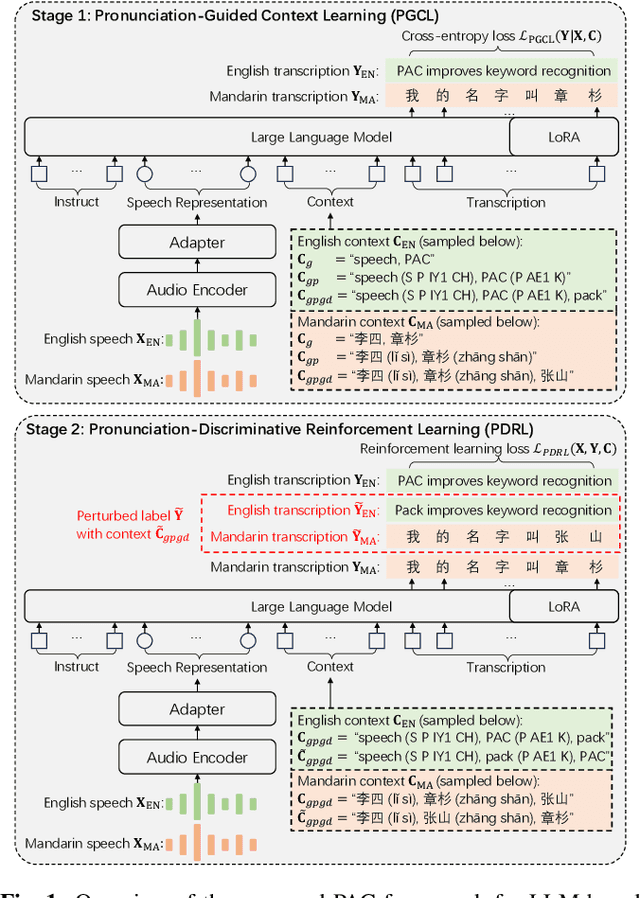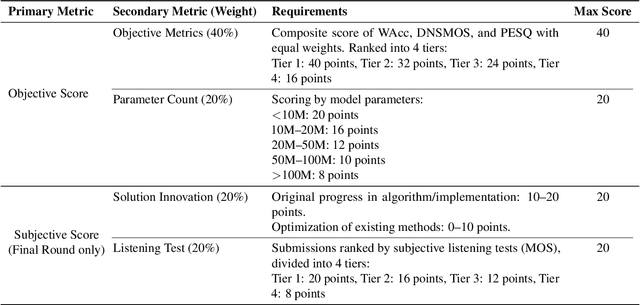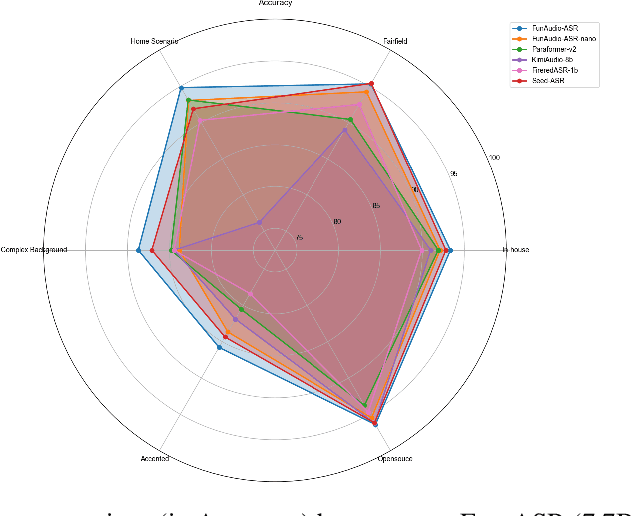speech
Papers and Code
Mixture of Low-Rank Adapter Experts in Generalizable Audio Deepfake Detection
Sep 17, 2025Foundation models such as Wav2Vec2 excel at representation learning in speech tasks, including audio deepfake detection. However, after being fine-tuned on a fixed set of bonafide and spoofed audio clips, they often fail to generalize to novel deepfake methods not represented in training. To address this, we propose a mixture-of-LoRA-experts approach that integrates multiple low-rank adapters (LoRA) into the model's attention layers. A routing mechanism selectively activates specialized experts, enhancing adaptability to evolving deepfake attacks. Experimental results show that our method outperforms standard fine-tuning in both in-domain and out-of-domain scenarios, reducing equal error rates relative to baseline models. Notably, our best MoE-LoRA model lowers the average out-of-domain EER from 8.55\% to 6.08\%, demonstrating its effectiveness in achieving generalizable audio deepfake detection.
A Lightweight Pipeline for Noisy Speech Voice Cloning and Accurate Lip Sync Synthesis
Sep 16, 2025Recent developments in voice cloning and talking head generation demonstrate impressive capabilities in synthesizing natural speech and realistic lip synchronization. Current methods typically require and are trained on large scale datasets and computationally intensive processes using clean studio recorded inputs that is infeasible in noisy or low resource environments. In this paper, we introduce a new modular pipeline comprising Tortoise text to speech. It is a transformer based latent diffusion model that can perform high fidelity zero shot voice cloning given only a few training samples. We use a lightweight generative adversarial network architecture for robust real time lip synchronization. The solution will contribute to many essential tasks concerning less reliance on massive pre training generation of emotionally expressive speech and lip synchronization in noisy and unconstrained scenarios. The modular structure of the pipeline allows an easy extension for future multi modal and text guided voice modulation and it could be used in real world systems.
Multi-Modal Embedding-based Target Speaker Enhancement
Sep 16, 2025Target Speaker Extraction (TSE) is a critical challenge in cocktail party scenarios. While leveraging multiple modalities, such as voice, lip, face, and expression embeddings, can enhance performance, real-world applications often suffer from intermittent modality dropout. This paper presents a comprehensive study on the interactions and robustness of various multimodal fusion strategies under varying degrees of modality dropout. We build upon a state-of-the-art audio-visual speech enhancement system and integrate four distinct speaker identity cues: lip embeddings for synchronized contextual information, a voice speaker embedding extracted via cross-attention for acoustic consistency, a static face embedding for speaker identity, and a novel dynamic expression embedding for frame-wise emotional features. We systematically evaluate different combinations of these modalities under two key training regimes: zero dropout and 80% modality dropout. Extensive experiments demonstrate that while a full multimodal ensemble achieves optimal performance under ideal (zero dropout) conditions, its effectiveness diminishes significantly when test-time dropout occurs without prior exposure during training. Crucially, we show that training with a high (80%) modality dropout rate dramatically enhances model robustness, enabling the system to maintain superior performance even under severe test-time missing modalities. Our findings highlight that voice embeddings exhibit consistent robustness, while the proposed expression embedding provides valuable complementary information. This work underscores the importance of training strategies that account for real-world imperfection, moving beyond pure performance maximization to achieve practical reliability in multimodal speech enhancement systems.
High-Energy Concentration for Federated Learning in Frequency Domain
Sep 16, 2025



Federated Learning (FL) presents significant potential for collaborative optimization without data sharing. Since synthetic data is sent to the server, leveraging the popular concept of dataset distillation, this FL framework protects real data privacy while alleviating data heterogeneity. However, such methods are still challenged by the redundant information and noise in entire spatial-domain designs, which inevitably increases the communication burden. In this paper, we propose a novel Frequency-Domain aware FL method with high-energy concentration (FedFD) to address this problem. Our FedFD is inspired by the discovery that the discrete cosine transform predominantly distributes energy to specific regions, referred to as high-energy concentration. The principle behind FedFD is that low-energy like high-frequency components usually contain redundant information and noise, thus filtering them helps reduce communication costs and optimize performance. Our FedFD is mathematically formulated to preserve the low-frequency components using a binary mask, facilitating an optimal solution through frequency-domain distribution alignment. In particular, real data-driven synthetic classification is imposed into the loss to enhance the quality of the low-frequency components. On five image and speech datasets, FedFD achieves superior performance than state-of-the-art methods while reducing communication costs. For example, on the CIFAR-10 dataset with Dirichlet coefficient $\alpha = 0.01$, FedFD achieves a minimum reduction of 37.78\% in the communication cost, while attaining a 10.88\% performance gain.
PAC: Pronunciation-Aware Contextualized Large Language Model-based Automatic Speech Recognition
Sep 16, 2025



This paper presents a Pronunciation-Aware Contextualized (PAC) framework to address two key challenges in Large Language Model (LLM)-based Automatic Speech Recognition (ASR) systems: effective pronunciation modeling and robust homophone discrimination. Both are essential for raw or long-tail word recognition. The proposed approach adopts a two-stage learning paradigm. First, we introduce a pronunciation-guided context learning method. It employs an interleaved grapheme-phoneme context modeling strategy that incorporates grapheme-only distractors, encouraging the model to leverage phonemic cues for accurate recognition. Then, we propose a pronunciation-discriminative reinforcement learning method with perturbed label sampling to further enhance the model\'s ability to distinguish contextualized homophones. Experimental results on the public English Librispeech and Mandarin AISHELL-1 datasets indicate that PAC: (1) reduces relative Word Error Rate (WER) by 30.2% and 53.8% compared to pre-trained LLM-based ASR models, and (2) achieves 31.8% and 60.5% relative reductions in biased WER for long-tail words compared to strong baselines, respectively.
MSR-Codec: A Low-Bitrate Multi-Stream Residual Codec for High-Fidelity Speech Generation with Information Disentanglement
Sep 16, 2025Audio codecs are a critical component of modern speech generation systems. This paper introduces a low-bitrate, multi-scale residual codec that encodes speech into four distinct streams: semantic, timbre, prosody, and residual. This architecture achieves high-fidelity speech reconstruction at competitive low bitrates while demonstrating an inherent ability for information disentanglement. We construct a two-stage language model for text-to-speech (TTS) synthesis using this codec, which, despite its lightweight design and minimal data requirements, achieves a state-of-the-art Word Error Rate (WER) and superior speaker similarity compared to several larger models. Furthermore, the codec's design proves highly effective for voice conversion, enabling independent manipulation of speaker timbre and prosody.
The CCF AATC 2025: Speech Restoration Challenge
Sep 16, 2025
Real-world speech communication is often hampered by a variety of distortions that degrade quality and intelligibility. While many speech enhancement algorithms target specific degradations like noise or reverberation, they often fall short in realistic scenarios where multiple distortions co-exist and interact. To spur research in this area, we introduce the Speech Restoration Challenge as part of the China Computer Federation (CCF) Advanced Audio Technology Competition (AATC) 2025. This challenge focuses on restoring speech signals affected by a composite of three degradation types: (1) complex acoustic degradations including non-stationary noise and reverberation; (2) signal-chain artifacts such as those from MP3 compression; and (3) secondary artifacts introduced by other pre-processing enhancement models. We describe the challenge's background, the design of the task, the comprehensive dataset creation methodology, and the detailed evaluation protocol, which assesses both objective performance and model complexity. Homepage: https://ccf-aatc.org.cn/.
Token-based Attractors and Cross-attention in Spoof Diarization
Sep 16, 2025Spoof diarization identifies ``what spoofed when" in a given speech by temporally locating spoofed regions and determining their manipulation techniques. As a first step toward this task, prior work proposed a two-branch model for localization and spoof type clustering, which laid the foundation for spoof diarization. However, its simple structure limits the ability to capture complex spoofing patterns and lacks explicit reference points for distinguishing between bona fide and various spoofing types. To address these limitations, our approach introduces learnable tokens where each token represents acoustic features of bona fide and spoofed speech. These attractors interact with frame-level embeddings to extract discriminative representations, improving separation between genuine and generated speech. Vast experiments on PartialSpoof dataset consistently demonstrate that our approach outperforms existing methods in bona fide detection and spoofing method clustering.
Traces Propagation: Memory-Efficient and Scalable Forward-Only Learning in Spiking Neural Networks
Sep 16, 2025Spiking Neural Networks (SNNs) provide an efficient framework for processing dynamic spatio-temporal signals and for investigating the learning principles underlying biological neural systems. A key challenge in training SNNs is to solve both spatial and temporal credit assignment. The dominant approach for training SNNs is Backpropagation Through Time (BPTT) with surrogate gradients. However, BPTT is in stark contrast with the spatial and temporal locality observed in biological neural systems and leads to high computational and memory demands, limiting efficient training strategies and on-device learning. Although existing local learning rules achieve local temporal credit assignment by leveraging eligibility traces, they fail to address the spatial credit assignment without resorting to auxiliary layer-wise matrices, which increase memory overhead and hinder scalability, especially on embedded devices. In this work, we propose Traces Propagation (TP), a forward-only, memory-efficient, scalable, and fully local learning rule that combines eligibility traces with a layer-wise contrastive loss without requiring auxiliary layer-wise matrices. TP outperforms other fully local learning rules on NMNIST and SHD datasets. On more complex datasets such as DVS-GESTURE and DVS-CIFAR10, TP showcases competitive performance and scales effectively to deeper SNN architectures such as VGG-9, while providing favorable memory scaling compared to prior fully local scalable rules, for datasets with a significant number of classes. Finally, we show that TP is well suited for practical fine-tuning tasks, such as keyword spotting on the Google Speech Commands dataset, thus paving the way for efficient learning at the edge.
FunAudio-ASR Technical Report
Sep 15, 2025



In recent years, automatic speech recognition (ASR) has witnessed transformative advancements driven by three complementary paradigms: data scaling, model size scaling, and deep integration with large language models (LLMs). However, LLMs are prone to hallucination, which can significantly degrade user experience in real-world ASR applications. In this paper, we present FunAudio-ASR, a large-scale, LLM-based ASR system that synergistically combines massive data, large model capacity, LLM integration, and reinforcement learning to achieve state-of-the-art performance across diverse and complex speech recognition scenarios. Moreover, FunAudio-ASR is specifically optimized for practical deployment, with enhancements in streaming capability, noise robustness, code-switching, hotword customization, and satisfying other real-world application requirements. Experimental results show that while most LLM-based ASR systems achieve strong performance on open-source benchmarks, they often underperform on real industry evaluation sets. Thanks to production-oriented optimizations, FunAudio-ASR achieves SOTA performance on real application datasets, demonstrating its effectiveness and robustness in practical settings.
 Add to Chrome
Add to Chrome Add to Firefox
Add to Firefox Add to Edge
Add to Edge